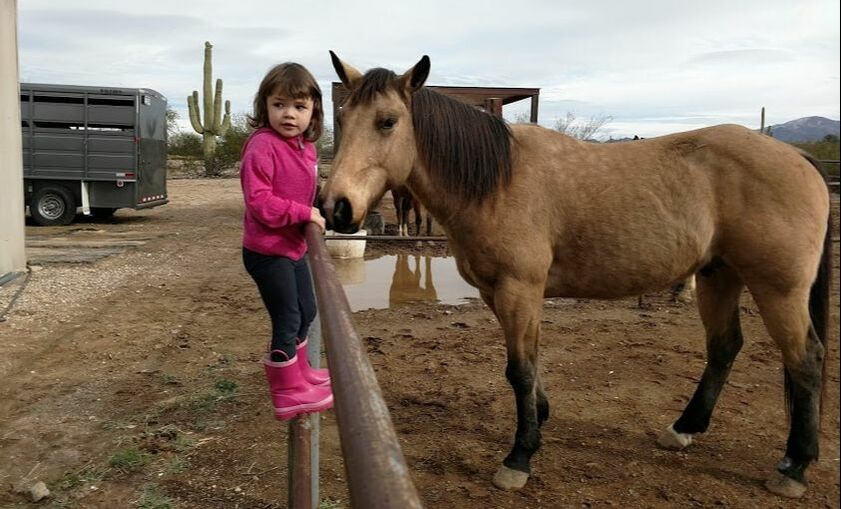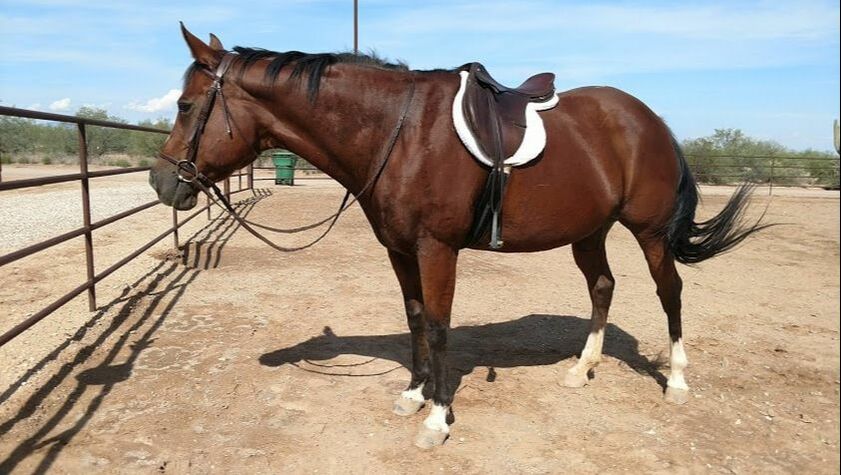|
This post may contain affiliate or sponsored links. Please read our Privacy Policy and Disclaimer. When Okie was younger, she was a very easy keeper. Now, she is 19 and I notice that she cannot maintain her body weight on her old diet. She does not quite fall into the “hard keeper” category yet, but her dietary needs have definitely changed. Feeding a hard keeper is very different than feeding the easy keeper. Every horse is an individual and needs his diet tailored to his specific needs, but these guidelines will help you create a plan to get your horse back to a healthy weight. Wormer Whenever one of my horses starts losing weight, I start by worming him. Although my horses are on a regular worming schedule, they occasionally come into contact with parasites that were immune to the type of wormer I last used. I check my records to see what I wormed my horse with and when, and then choose a different type of wormer. Zimectrin Gold (buy it here) and Panacur PowerPac (buy it here) are my go-to choices when I suspect my horse has worms. Float Teeth To properly digest forage, your horse’s teeth need to be in good condition for grinding. Check the condition of your horse’s teeth and float if needed. Rule Out Medical Issues If your horse has lost a significant amount of weight, it is worth calling the vet to rule out any serious medical issues. The vet may do blood work or other diagnostics to determine why your horse is losing weight if he has been recently wormed and his teeth are in good condition. Add Forage High quality forage is the basis of your hard keeper’s diet, and the easiest way to add calories is to feed him more forage. Early cutting coastal hay offers the most nutrition per pound. Late cutting coastal hay and Bermuda grass are much lower in nutrition and should not be fed to hard keepers. For the average 1,000-pound horse, start by adding five to six pounds of early-cutting alfalfa per day. Choose bales that are leafy rather than full of thick stems. If good hay is hard to find, alfalfa cubes are another option. These are usually from early, leafy cuttings and add quality nutrition to your horse’s diet. You may also choose to add alfalfa pellets, which are more readily available in some areas. Feed five to six pounds of cubes or pellets per day, just like you would feed baled alfalfa. Beet Pulp Beet pulp is the “go-to” forage for many owners of hard keepers. Beet pulp is the fiber left over after the sugar is removed from sugar beets during processing. This fiber is more digestible than the highest quality hay, so it is an easy way to add calories. Feed no more than two to three pounds of beet pulp per day. This is approximately ten percent of your horse’s ration. Beet pulp must be soaked before feeding to prevent choke. Place the beet pulp in a bucket and cover with two to three times as much water. You can use warm or cold water but avoid hot water as this cooks the beet pulp and diminishes the nutrient content. Soak for 30 to 60 minutes before feeding, then drain and rinse to remove excess sugar. Most horses will eat beet pulp by itself, but you can also mix it with your horse’s grain ration if he is a picky eater. Soak only the amount of beet pulp you need for the feeding since it ferments quickly. Grain If you have maximized the amount of forage your easy keeper can eat each day, the next step in improving his condition is adding grain to his diet. Choose a commercial feed that has six to ten percent fat. I feed my horses Omolene 200, which has six percent fat. I also like Nutrena’s SafeChoice Perform Horse Feed, which as nine percent fat. As your horse ages, you may need to switch them to a senior feed. These feeds are specifically designed to meet the nutritional needs of senior horses. In the past, I’ve used Triple Crown Senior with great results. Be sure to read the labels on your senior feed because some do not contain enough fat to be effective. Be cautious when adding more grain to your easy keeper’s diet. If you feed more than five pounds per feeding, the grain does not completely break down in the horse’s foregut, which causes problems in the hindgut, including colic, colonic ulcers, and hindgut acidosis. Large amounts of grain can also cause laminitis. Fat Fat has more calories per gram than carbohydrates or protein, so it is an effective way to add weight to your easy keeper. Horses can safely digest up to 20 percent of their diet by weight as oil. The easiest way to add fat to your hard keeper’s diet is to top-dress his grain with a plant-based oil, such as corn, soybean, sunflower, or canola. Remember, oils have no nutritional value beyond adding calories, so use caution not to add so much oil that your horse does not want to eat an adequate amount of forage and grain. Another way to add fat is with fat-rich ingredients such as rice bran and flaxseed. These have a lower fat percentage than oils, so you have to feed more to get the same fat content. Rice bran has a high phosphorus content and does not naturally contain enough calcium, so choose rice bran that has calcium added to avoid metabolic bone disorders. Flaxseeds are high in Omega-3s but must be ground to be digested. You can use a coffee grinder (buy it here) or a grain grinder (buy it here). Depending on how much you feed, it may be worth investing in a grain grinder. The third way you can add fat to your horse’s diet is with a commercial high-fat supplement. I’ve used Purina’s Amplify (buy it here) with great success, and MannaPro’s Cool Calories 100 (buy it here) is my hunter jumper friend’s go-to for her high-level competition horses. Will Extra Calories Make My Horse Hot?
Some equestrians are concerned that feeding more calories will make their easy keeper hot, especially if he is a saddle horse. Adding extra calories can make your horse hot, but how you add them makes a difference. The stomach breaks down simple carbohydrates and these are absorbed into the blood stream 40 minutes after your horse eats. He can experience “sugar high” type symptoms if he has more grain in his diet than he needs. Even if you limit grain, keep in mind that a horse who consumes adequate calories feels good and this increases his energy level. If he is consuming too many calories and not getting enough exercise, he will act hot. The key is balancing the calories so that he gains weight but does not have excessive energy to burn. What are your best tips for feeding a hard keeper? Let me know in the comments below!
1 Comment
10/21/2023 08:02:15 am
I wanted to express my gratitude for your insightful and engaging article. Your writing is clear and easy to follow, and I appreciated the way you presented your ideas in a thoughtful and organized manner. Your analysis was both thought-provoking and well-researched, and I enjoyed the real-life examples you used to illustrate your points. Your article has provided me with a fresh perspective on the subject matter and has inspired me to think more deeply about this topic.
Reply
Leave a Reply. |
AuthorWelcome! I've been a freelance writer since 2002 and have numerous horse-related articles published in print and online publications. I have a Bachelor of Science degree from Rocky Mountain College with a major in Equestrian Studies and a minor in Business Management. My current business ventures include High Plains Arena and real estate investing. Archives
March 2019
Categories
All
|
Proudly powered by Weebly




 RSS Feed
RSS Feed